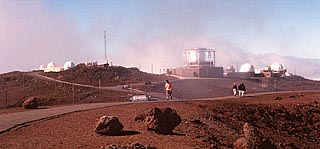 |
| Science City, the cluster of scientific observatories atop Haleakala, is the preferred site for a joint Hawai‘i-United Kingdom educational project.
Advertiser library photo • Jan. 4, 1998 |
By Timothy Hurley
Advertiser Maui County Bureau
WAILUKU, Maui — There’s a plan in the works to open up the universe above Science City on Haleakala to students and astronomers of all ages, both in Hawai‘i and the United Kingdom.
The University of Hawai‘i’s Institute for Astronomy and the Faulkes Telescope Corp. are working together to place a two-meter telescope atop the summit. It would be the largest such instrument anywhere dedicated to education.
A draft environmental assessment was released Jan. 23 describing the proposed $10 million observatory, a portion of which would be financed by the Dill Faulkes Educational Trust in the United Kingdom. The university is planning to contribute $1 million in in-kind services and is looking for a donor to cover other project costs.
The aim is to have the new observatory — it would be named for British businessman Martin "Dill" Faulkes, founder of the Dill Faulkes Educational Trust — operational in about a year.
"This is a terribly exciting project," said Karen Rehbock, assistant to the director at the UH Institute for Astronomy. "Something like this has never, ever been done in the world."
The telescopes atop Haleakala are generally off-limits to the public, the domain of military or scientific researchers. UH astronomy professor James Heasley said the Faulkes Telescope represents a new generation of astronomical telescope, capable of being operated remotely from control centers in the United Kingdom or Hawai‘i with no operator on the mountain required.
By directing the telescope's operations remotely over the Internet, Heasley said, students in their classrooms would be able to retrieve "real-time" observations.
For the younger in the U.K.
In the United Kingdom, students ranging from age 5 to college level would be able to use the telescope, with guidance from teachers and professional astronomers. In Hawai‘i, use initially would be focused on college undergraduate and high school students.
While the telescope proposal has been welcomed enthusiastically by Maui educators, the Maui County Council and the Maui Economic Development Board, the project has raised opposition.
Native Hawaiian leader Charles Kauluwehi Maxwell Sr. and Mary Evanson, president of the Friends of Haleakala National Park, said they can’t support additional construction at the mountain’s summit without a master plan for development at Science City.
Maxwell described Haleakala as sacred and said the Faulkes project threatens the sanctity and spirituality of one of the most important historical sites in the Islands.
"It may be wonderful for the children and all, but you should not put things on top of Haleakala, especially if there is no plan," he said at a Maui County Council meeting in December.
In 1999, Maxwell protested at a ceremony at the Maui Research & Technology Center in Kihei to formally announce the project.
Two years ago, Maxwell and Evanson were among the organizers of those opposing a proposal to move radio and television transmitters to a site below the volcano’s 10,023-foot summit. Last year, University of Hawai‘i Institute for Astronomy scrapped its environmental planning associated with that effort.
A master plan for Science City was once in the works, with the state Legislature approving a UH proposal to prepare the plan, but financing was shot down by the governor. Mike Maberry, the Institute for Astronomy’s Maui manager, said UH is forging ahead with obtaining state approvals for the Faulkes Telescope because further delay could threaten its financing.
Under the proposal, the telescope would be housed in a 3,300-square-foot observatory with an enclosure that opens like a clam shell and is capable of exposing the telescope to the night sky.
Auto pilot
The telescope’s control system could sense if the weather is good enough to observe, point the telescope, take the images requested and then move to the next observation. It would automatically adjust one or the other side of its "clam shell" to protect the telescope from buffeting by the wind. At the end of the night, or if the weather deteriorates, it would be closed and the telescope shut down.
Maintenance would be restricted to occasional cleaning and lubrication.
The initial instrument to be installed on the Faulkes Telescope is a state-of-the-art electronic camera with 4 million individual picture elements, or pixels. Each image taken by the telescope would cover an area of sky about half the size of the full moon.
Students in the United Kingdom will be able to use the telescope during daylight hours there, when it is nighttime here. The plan is to add a $2 million electronic camera that is sensitive to infrared radiation by July 2002. This would allow operation of the telescope in Hawai‘i during daylight hours, opening up greater use by younger students here.
In the UK, the Faulkes Telescope would be operated from the National Maritime Museum at the original site of the Royal Greenwich Observatory. A secondary control center would be established at Maui Community College in Kahului.
Project officials said they hope to encourage research projects in which students in Hawai‘i would collaborate over the Internet with their counterparts in the UK. They also want to open up use of the telescope to Bishop Museum, amateur astronomy groups and other users.
[back to top] |

